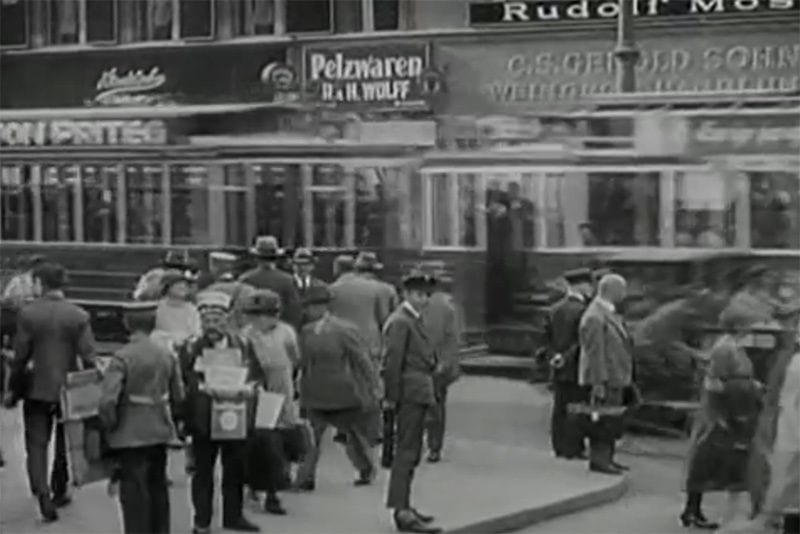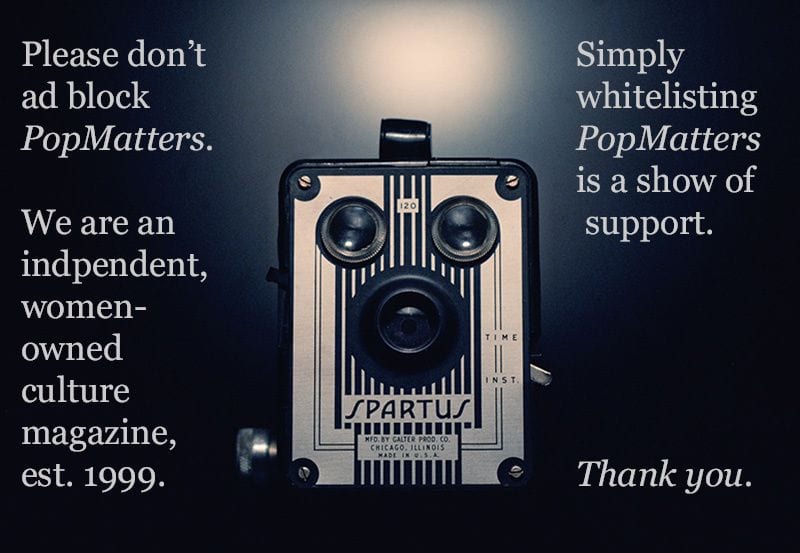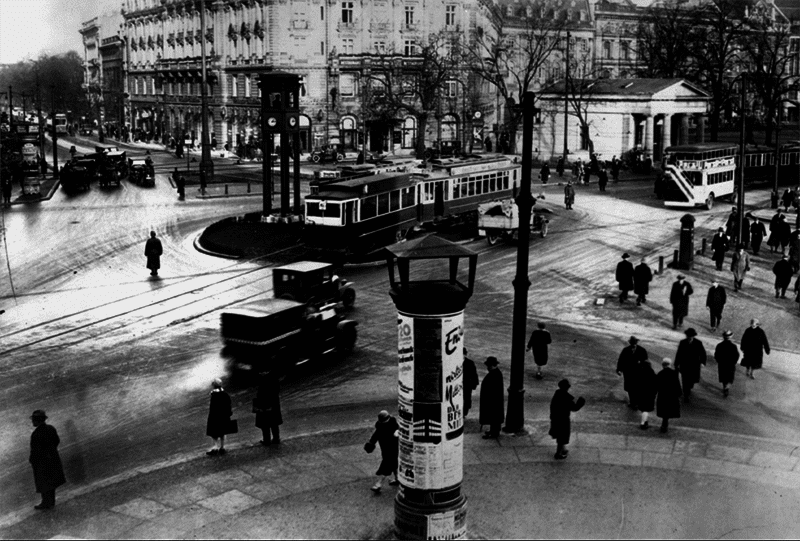
Berlin, Symphony of a Great City (die Sinfonie der Großstadt, 1927) occupies rather contested critical space within the history of film. While it’s not the first “city film” or “city symphony” (a non-narrative filmic account of a single city told without characters, without plot, and usually without explanatory intertitles)—critics tend to bestow that honor upon Manhatta (1921) by the painter Charles Sheeler and photographer Paul Strand—it is perhaps the quintessential early iteration of that celebrated genre that dwells within the interstices of the documentary and the experimental film. Its intensely vigorous approach to visual rhythm, its entrancing formal control, its invigorating use of double exposure and jump cuts follow upon the earlier animated works of director Walther Ruttmann and anticipate the much-lauded Man with a Movie Camera (1929) by Dziga Vertov. The latter film, however, tends to overshadow Berlin which, in retrospect, strikes many viewers as a rather wan imitation (avant la lettre) of Vertov’s innovations—although, strictly speaking, Vertov’s work fits rather uncomfortably within the “city film” genre that Berlin has come to define.
On the other hand, critics seeking a clear political statement from the film generally find little more than disappointment. As Alex Barrett, the director of the more recent “city film” London Symphony (2017), clarifies in his audio commentary that appears as a special feature of Flicker Alley’s new DVD edition of Berlin, several critics objected to the anonymous quality of the many people documented in the film. Ruttmann charts the movements of crowds of children, workers, swimmers, rowers, and so on, but only occasionally focuses on a person as an individual. Moreover, many of the most striking scenes in the film avoid the intrusion of people altogether, concentrating instead on the operation of mechanical devices (notably trains and factory machines)—even when those people must be there in some sense for the mechanisms to operate at all.
One of the most remarkable of such scenes takes place as the climax of Act I of the film. It’s staged in a factory that produces light bulbs. We see the whirling mechanisms of the machines, the molten glass being poured into the molds, the emission of the blown glass bulbs—all without a single discernible human presence. Barrett suggests that some critics saw this as the erasure of human labor and the fetishization of the machine. More ominously still, certain critics read this scene as a prefiguration of the Nazi ethos—Ruttmann would go on to assist Leni Riefenstahl in the notorious Nazi propaganda film Triumph of the Will (1935).
However, other scenes—notably one where Ruttmann juxtaposes a phalanx of men heading to work in a factory with cattle presumably being marched to slaughter—may be read as hewing closer to a Marxist critique of the abuses of capitalism and the denigration of workers alienated from their labor. Other moments are, I think, entirely ambiguous. The climax of Act II jumps back and forth between operators answering phones and frenetic animals (chattering monkeys, a dog fight). Is this the reduction of human endeavor to empty animalistic activity? or is it a demonstration of both the link and the distinctions between animal communication and mechanically mediated human interaction? The lunchtime scene of Act IV—intercutting shots of the rich enjoying opulent repasts with the poor satiating their hunger with more meager fare while the animals of the zoo are fed by their keepers—can be understood as an indictment of the unjust inequality of access to the basic necessities (reducing the poor to the level—or even below the level—of caged animals) or as a universalizing gesture that claims little more than that all living creatures require nourishment, fuel that fires the engines of their biological mechanisms.
In short, Ruttmann’s Berlin has continually been appraised and criticized for the manner in which it deals with humanity and human concerns. Even German screenwriter Carl Mayer, who first developed the idea for the film, left the project in protest against what he saw as Ruttmann’s dehumanization of the city and its denizens. Given our awareness of Ruttmann’s later association with Riefenstahl and the Nazi regime, such criticisms seem trenchant and well-deserved. And yet, the abstraction from the level of the human to something deeper, inclusive of the human but not affording it a privileged space, is not a philosophical move reserved for National Socialism and its devotees.
Indeed, one of the more harrowing elements of western philosophy is the insistence (on the part of many of its most famous and influential proponents) on the qualitative ontological distinction between human thought and the rest of the world. Descartes, for example, divides the world into the res cogitans (the thinking thing—which, for Descartes, only refers to the human, the angelic, and the divine) and the res extensa (the extended thing—inert matter). Even animals, which Plato and most other philosophers believed must be ensouled in some manner in order to be animate at all (anima being the Latin for “soul”, after all), are for Descartes little more than automata, and thus just more refined bodies or machines carefully programmed by God (the ultimate res cogitans) to react in a mechanical fashion to the surrounding world. From a Cartesian point of view (and despite centuries of refinement, many philosophical positions still retain this assumption of a qualitative difference between the human and the non-human—what Slavoj Zizek terms the ontological catastrophe of the emergence of rational thought), Ruttmann’s Berlin must indeed be seen as the defamatory dehumanization of the human, the derogation of human autonomy and dominion over a world of indifferent matter, a reduction of the divine spark in humankind to the status of another mere thing.
But perhaps it is precisely this arrogance, this self-assured insistence that we are above and beyond the ken of all other existing worldly things, that has led to the political, ecological, and existential crises endemic in today’s society. Because we believe ourselves ontologically separate from the rest of the world, we don’t always recognize the deep interconnections between our existence and the threatened existence of our world. Since Gilles Deleuze, and more recently in the work of philosophers such as Graham Harman and Manuel Delanda, thinkers have been exploring the notion of a flat ontology; what I mean by that term, in this context (it is sometimes used otherwise), is that there is no à priori (but perhaps some à postériori) reason for privileging human modes of existence over other modes. Harman, for example, promotes the notion that just as we only have indirect access to things (in themselves, in Kantian language) through our perceptions, so objects only have indirect access to each other. The flame, in Harman’s oft-repeated and memorable example, doesn’t burn the cotton “in itself” but rather only touches the cotton indirectly insofar as the cotton is flammable; that is, the flame engages with the cotton only in its flammability.

Such an idea has many profound implications worth exploring but for our purposes I’m only interested in the notion that all objects (including humans) interact with other objects indirectly. They remain integral to themselves; they are what they are. Insofar as one object engages with another, it does so always at a kind of remove. If you add to this Deleuze and Delanda’s interest in flows of intensity and the notion of emergence (that compound objects like clouds or groups of people manifest properties that are more than simply the sum of the properties of their components), then there appears to be another manner of viewing Ruttmann’s Berlin that doesn’t simply condemn it to being understood as a proto-Nazi project of dehumanization.
The hermeneutic root of Berlin, as I see it, involves a penetration of the surface objects it presents to reveal the underlying flows and processes that inform them. The film announces its intention immediately. It opens with a shot of a body of water in a state of flow. The shot is up close. We don’t see any sense of a shore or a pier, no animals or boats, just the gentle welling of small waves. This gives way to the only animated portion of the film (remember that Ruttmann was already established as the director of abstract animated films). It seems to be a representation of the rising sun but it is set on a loop. In place of an event, a process based on accelerating repetition of an eternally tumbling rectangle (the horizon?) and luminous orb. More falling rectangles cut directly to the descending guardrails at a railroad crossing and we are on a past-paced railway ride into the city of Berlin.
Ruttmann emphasizes motion with a focus on wheels as the motive force of progress and the tracks (and rhyming images such as passing telephone wires) as that which serve to grant that progress directionality. Outside of the window, buildings and train yards pass in review. There is thus far no outward sign of life. No people, no animals and yet a livelier set of images is hardly imaginable. We know that these buildings house human beings, that these fields must be replete with wildlife but all we see is the mechanisms of the train and evidence of inexorable motion. If Berlin is, in part, a meditation on modernism and a celebration of its mechanistic efficiency, its thesis seems to be that modernism participates in the general acceleration of the processes that inform nature.

One way to understand the form of the film is to see it as producing states of flow that reinforce a flat ontology among humans, animals, machines, buildings, bodies of water, etc. The notion of flow here applies equally to the manner in which the film itself proceeds as an assemblage of shots. As the train moves, we get the impression of acceleration but it is not the train per se that is picking up speed (at least not discernibly) but rather the rate of presentation of the shots increases. Everything comes to a relative halt once we arrive in Berlin. Soon we are shown static shots of the façades of buildings, highlighting their architectural coolness and placidity. But the camera jumps from one façade to the next—these images also create a flow.
The workers flow into the factory, customers flow into shops, children flow into schoolyards. The lightbulb factory is a series of intersecting flows cut off only to the extent that they produce the glass bulbs which flow forth from the endless activity. The consumption of food, the chatter of telephone operators and quarreling monkeys, the continuous motion of traffic—everything is caught up in flow. In this sense, Ruttmann’s critics are correct. The level of ontological concern here is not on the scale of the human. This isn’t a film about humans per se, not even denizens of Berlin. It is a film about Berlin at its own ontological level as composite object.
All objects (or nearly all) are composite objects. I am a composite of flesh and bone and muscle and sinew and something called consciousness. The hat I wear is a composite of threads. And yet we are used to treating these objects as singularities. I rarely see my brother Brent as a composite of limbs, beard, and twinkling eyes (although I can see him that way). Rather, I tend to see Brent as an “all-at-once”. I don’t construct him anew each time through my sensory perception of his various parts.
A city too can be (and often is) treated as a singularity. We seem to know what we mean when we say “the city of Berlin” where we intend Berlin not just as an example among many of what one calls a city but rather as a specific object in its own right. And yet, more than myself or my hat or my brother Brent, Berlin presents itself to us as a composite object. When we tell people we have visited Berlin, they might very well ask us “did you see the Brandenburg gate? What about the Reichstag building? What are the people there like? Are they friendly?” In other words, we are accustomed to constructing our sense of Berlin out of its components. Indeed, it’s rather difficult to conceive of Berlin as an “all-at-once”.

Now, while the film Berlin can hardly be said to accomplish that nigh-impossible feat (of figuring the city as an “all-at-once”) it does manage to lead us toward an insight into the singularity of Berlin and how that singularity is to be understood. Those flows all tend toward the composite object of Berlin and that composite object is more than simply the sum total of those flows. The odd juxtapositions that trouble so many critics seem to me to suggest the kinds of connections between disparate components of a city that become more than metaphorical connections—rather the flow into the character of the city as such. Just as our singularity as human beings is composed of flows of food consumption, flows of blood, flows of mucus, flows of information through our nervous systems, so Berlin is composed of flows of construction, flows of traffic, flows of work, flows of desire (human and otherwise). And just as whatever makes my brother Brent more than simply a composite of those flows, so Berlin is more than the components through which it subsists.
In a sense, a city can be seen as an assemblage that, through emergence, makes a series of cuts into the flows of which it is composed. Flows of walking workers and vehicular traffic are “cut” by the layout of roads and intersections; the playtime of children is “cut” by the school calendar; the consumption of animals and humans is “cut” by a feeding schedule; the flow of trains is “cut” by the train schedule (which is “cut” by the standard apportioning of time in a day—more arrivals during daylight hours, for example—which is further “cut” by the oscillation of the flows of sunlight). Natural elements like water and sunlight are not separate from the city, they are additional (even primary) flows that enter into the assemblage.
The film, by its very nature, continues this process of cutting. The flows that Ruttmann documents are cut by his choice of shots, when to initiate them and when to discontinue them. Furthermore, flows are created by his juxtapositions. The film is more than a document of the city; it furthers the city’s processural trajectory.
This is what characterizes Berlin as a “city film” and prevents it and other city films from becoming reduced to a mere cinematic travelogue. The point is not to operate at the level of the components (as a travelogue would) but rather to get a sense of how the components flow into the whole. This is not dehumanization in the pejorative sense set forth by Ruttmann’s critics. The film is not meant to be at the level of the human but at the level of the city—and the city is more than its various components, including its human components. The magic of Berlin is its ability to provide an insight into the emergent qualities that make a city what it is, beyond being a mere composite of the elements within its geographical boundaries.
Flicker Alley presents a new edition of the masterly city film Berlin, Symphony of a Great City. The only “extra” is an audio commentary by director Alex Barrett, whose London Symphony is also available through Flicker Alley. It is well worth hearing and the film itself, of course, bears repeated viewing.


![Call for Papers: All Things Reconsidered [MUSIC] May-August 2024](https://www.popmatters.com/wp-content/uploads/2024/04/all-things-reconsidered-call-music-may-2024-720x380.jpg)



